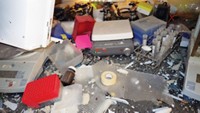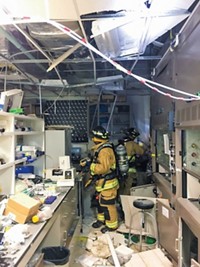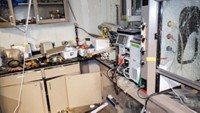Advertisement
Grab your lab coat. Let's get started
Welcome!
Welcome!
Create an account below to get 6 C&EN articles per month, receive newsletters and more - all free.
It seems this is your first time logging in online. Please enter the following information to continue.
As an ACS member you automatically get access to this site. All we need is few more details to create your reading experience.
Not you? Sign in with a different account.
Not you? Sign in with a different account.
ERROR 1
ERROR 1
ERROR 2
ERROR 2
ERROR 2
ERROR 2
ERROR 2
Password and Confirm password must match.
If you have an ACS member number, please enter it here so we can link this account to your membership. (optional)
ERROR 2
ACS values your privacy. By submitting your information, you are gaining access to C&EN and subscribing to our weekly newsletter. We use the information you provide to make your reading experience better, and we will never sell your data to third party members.
Safety
Hawaii explosion cost a researcher an arm
Electrostatic spark likely ignited tank containing mix of hydrogen, oxygen, and carbon dioxide gases
by Jyllian Kemsley
December 14, 2016
| A version of this story appeared in
Volume 94, Issue 49

Calls for heightened attention to laboratory risks continued in 2016 after postdoctoral researcher Thea Ekins-Coward lost an arm and suffered other injuries in a lab explosion at the University of Hawaii (UH) at Manoa on March 16.
Ekins-Coward was working for the Hawaii Natural Energy Institute under researcher Jian Yu. At the time of the explosion, she was preparing a gas mixture to be used to feed bacteria to produce biofuels and bioplastics.
The gas mixture of 55% hydrogen, 38% oxygen, and 7% carbon dioxide was contained in a 49-L steel tank designed for compressed air, not for hazardous gases, according to an investigation report issued by the University of California Center for Laboratory Safety (UCCLS). The tank was not electrically grounded.
Tests commissioned by UCCLS ruled out all possible causes of the explosion other than a static discharge. Prior to the incident, Ekins-Coward had experienced static shocks when touching the tank, as well as a smaller explosion when using a 3.8-L tank.
“The overall underlying cause of the accident was failure to recognize and control the hazards of an explosive gas mixture of hydrogen and oxygen,” UCCLS reports.
“The message to other researchers is that they need to do a better job of educating themselves about the hazards of the materials they’re working with” and what can go wrong, says Craig A. Merlic, UCCLS executive director and a UCLA chemistry professor. Campus safety personnel “need to have conversations with researchers and guide them to the resources that are available” to help conduct experiments safely, he adds.
The explosion cost about $716,000 in infrastructure damage and $60,000 to $100,000 in equipment losses, and UCCLS was paid $88,000 to investigate the accident, says UH spokesperson Dan Meisenzahl.
The Hawaii Occupational Safety & Health Division initially cited UH for 15 workplace safety violations that carried a total fine of $115,500. The violations were later combined into nine and the fine was reduced to $69,300.
C&EN's YEAR IN REVIEW
Top Headlines of 2016
- Hawaii explosion cost a researcher an arm
- TSCA reform crossed the finish line
- U.S. elected Trump as president
- The periodic table got four new elements
- Post Dow-DuPont, chemical deal-making waned as 2016 advanced
- Labs made advances in Zika research
- Four ag giants to rule them all
- 2016 Nobel Prize in Chemistry at a glance
- Brexit bomb exploded
- Focus returned to Iran's chemical industry
- Overtime pay limit doubles under Obama administration
- The CRISPR craze continued
- Perfluorinated compounds got increased scrutiny
- From the lab to the market
- Paris Agreement to curb climate change took off
- World chemical production at a glance
- Flint's water woes lingered
- As China's economy slowed, chemical makers adjusted
- Mostafa A. El-Sayed won the 2016 Priestley Medal
- ACS members on average fared better than young graduates in employment surveys
- ACS invests internationally
- Spun-off firms found their footing in 2016
- Remembering the Nobel laureates we lost in 2016
- ACS proposed chemistry preprint server
- Berkeley College of Chemistry avoided reorganization
- Fight against opioid epidemic continued in 2016
- Noble gas shortages averted, for now
- The shale gas boom by the numbers
- Crop protection products in the crosshairs
- ACS launched new journals
- Website search terms of the year
- Biobased materials hit the big time
- No better deal emerged for Mossville, La.
- U.S. prepares for national food labeling standard
Top Research of 2016
- Mini factory made drugs on demand
- World's first PET-munching microbe discovered
- Liquid metals went to work
- Methylene activation reached new heights
- Biological structures of the year
- Wearable sensors were 'the' fashion accessories of 2016
- Scientists beefed up the antibiotic arsenal
- An enzymatic route to carbon-silicon bonds
- Single-atom catalysts gained a toehold
Revisiting Research of 2006





Join the conversation
Contact the reporter
Submit a Letter to the Editor for publication
Engage with us on Twitter